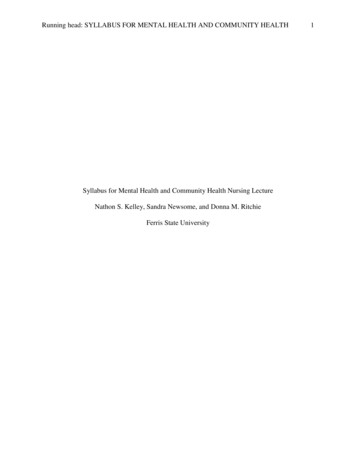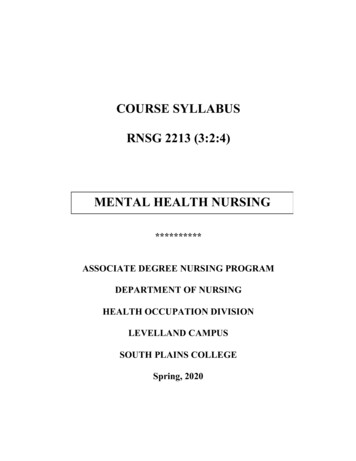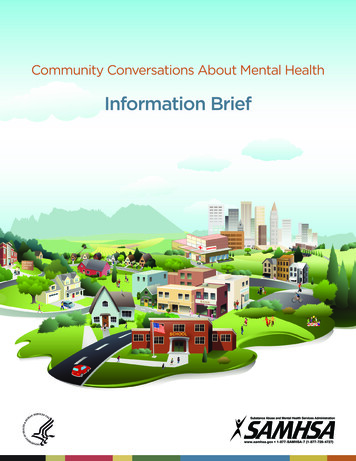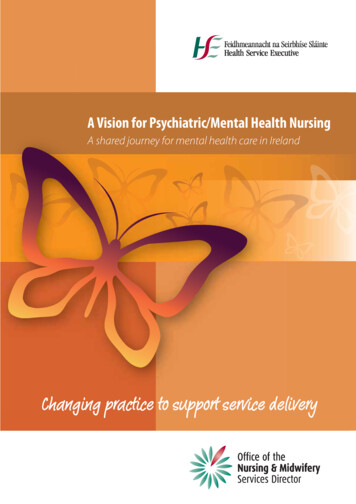
Transcription
Running head: SYLLABUS FOR MENTAL HEALTH AND COMMUNITY HEALTHSyllabus for Mental Health and Community Health Nursing LectureNathon S. Kelley, Sandra Newsome, and Donna M. RitchieFerris State University1
SYLLABUS FOR MENTAL HEALTH AND COMMUNITY HEALTHSyllabus for Mental Health and Community Health Nursing LectureThe creation of a syllabus is an important part of how an instructor communicates themanner in which the course will operate and develop. The syllabus sets the tone for the courseweather that is: warm and friendly, formal, condescending, or confrontational (Center forTeaching Excellence, 2012). An effective syllabus spells out the expectations for the course indetail and lists how the student will be evaluated. An educator would want to assess the studentslearning styles and adjust their teaching technique based on that assessment.With these thoughts in mind a syllabus was created for a combination mental health andcommunity health nursing class. A group of three individuals was created to assemble thissyllabus. This paper will look at the process that the group used to create the syllabus. Anassessment of how decisions were made and conflict resolutions will be discussed.Course ObjectivesThe course framework is comprised of the outcomes, competences, and objectives(Billings & Halstead, 2009). Billings & Halstead (2009) note that the use of learning outcomeswas prevalent during the 1980’s when accrediting agencies encouraged educators to focus onmeasuring student performance. Since then the expectation of graduates has expanded.Employers want competent and knowledgeable nurse graduates who can function proficiently inthe workforce.The course objective describe what the instructor wants the student to learn, while theoutcomes indicate what the student actually learned (University of Connecticut, 2011). Courseobjectives can be written to reflect the three learning domains, which are cognitive, affective,and psychomotor (Billings & Halstead, 2009). The components of the course objective include:the learner or students, the behavior that the learner should be able to do, under what condition,
SYLLABUS FOR MENTAL HEALTH AND COMMUNITY HEALTHand to what extent. The Bloom’s Taxonomy action verbs are used to link the learning objectivesto the student’s behavior.According to Billings & Halstead (2009) cognitive learning could be measured byrequiring the student to write an assignment, develop a portfolio, or take a test. Outcomes in thepsychomotor domain are usually measured during clinical practice or simulation. The affectivedomain identifies the nursing student’s behavior levels, as they gain more experience andprogressed through the program. The nursing student has met the outcome objective, when thehighest level had been obtained.The objectives for this syllabus were created using all the techniques laid out byBillings & Halstead (2009). Since this is a combination class two sets of objectives needed tocreated and then integrated. The objective was to not have the class feel like it was two classeslumped together, but rather a strategic blending of two often intertwined nursing subjects. Theobjectives were first proposed in a rough draft. This rough draft went through several changes.One change was the verification that all three domains were being covered. The objectives werefurther refined until all three members of the group agreed on them. The finalized objectives canbe found in the appendix.Knowles model of adult learning can be used to help the educator understand howage can affect learning (Billings & Halstead, 2009). Older students have multiple roles andresponsibilities with job and family and because of these demands; they feel that they do nothave time to waste Adult-learning serves a purpose, a desire to solve a problem. Adult learnersassume more responsibility for their learning and as a result are more actively involved in thelearning process. Adult learners already have life experiences, which they can draw on. Theadult learner responds to more choices and control. Taking this all in to consideration we
SYLLABUS FOR MENTAL HEALTH AND COMMUNITY HEALTHdecided that we would allow the students to select a group and topic from a specified list, thatthey would research and present to the class. Not only would they learn the topic, they woulddevelop their communication, collaboration and teaching skills. Bradshaw & Lowenstein (2007)noted the importance of using innovative teaching strategies. Nursing education has moved awayfrom teacher centered teaching strategies to student center strategies. Student centered strategiesare more active forms of learning, that are more conducive to developing critical thinkingSyllabus ElementsAccording to Billings and Halstead (2009) the syllabi explains the course requirements,learning objectives, and the educator’s expectations. It would contain a description of thecourse, course objectives, course credit hours, class schedule, attendance policies, teachingstrategies, outlines, due dates, late work policy, and the expected behaviors required to pass thecourse. It should also contain the faculty responsibilities, teaching methods, and evaluationmethods. A statement that informs students with disabilities, that they need to notify facultyabout required accommodations should also be include in the syllabi. The syllabus is the roadmap to the course and should be handed out on the first day of class.The layout of the syllabus and the elements that were included were decided on by thegroup. The group chose to follow the recommendations of Billings & Halstead (2009) whendeveloping the syllabus. The group also looked at several syllabi from various instructors toestablish a general template. All members quickly agreed on this layout without anydisagreement. The syllabus includes: course description, instructors name and contactinformation, course objectives, syllabus changes disclaimer, required course materials, gradedetermination, school grading system, attendance policy, academic integrity policy, student
SYLLABUS FOR MENTAL HEALTH AND COMMUNITY HEALTHconduct rules, ethical and professional expectations, class schedule, description of assignments,and assignment grading rubric.EvaluationGardner’s theory of multiple intelligence, defines intelligence as the ability to solveproblems (Bradshaw & Lowenstein, 2007). Intelligence presents itself in seven forms, whichare: linguistic, musical/rhythm, logical/mathematical, visual/spatial, bodily kinesthetic,interpersonal intelligence in regards to relationships with others and interpersonal intelligencerelated to a persons inner thought process. Some examples of linguistic strategies would bewriting assignments. Creating a rhythmic pattern to help remember information would be anexample of rhythm strategy. Dramatizing events, presentations, role-playing, or using videocameras could be considered visual/spatial and bodily kinesthetic strategies. Interpersonalintelligence in regards to relationships with others could be demonstrated by peer tutoring orgroup projects. Strategies such as journaling, independent assignments, or researching a topic ofinterest could utilize interpersonal intelligence, related to persons’ inner thought process. Notonly could these strategies be used to help the students learn, they could be used to evaluate aswell.Evaluation of the curriculum, the instructor, and the student are all needed to insure theprogram’s effectiveness. Billings & Halstead (2009) reviewed ways the educator coulddetermine if a student had achieved the learning out comes. Evaluation requires the educator tomatch the assessment strategy with the different domains of learning, which are cognitive,psychomotor, and affective domains (Billings & Halstead, 2009). Cognitive learning could bemeasured by requiring the student to write an assignment, develop a portfolio, or take a test.
SYLLABUS FOR MENTAL HEALTH AND COMMUNITY HEALTHOutcomes in the psychomotor domain are usually measured during clinical practice orsimulation. The affective domain identifies the nursing student’s behavior levels, as they gainmore experience and progress through the program. These behavior levels are: receiving,responding, valuing, organization of values, and value complex (Billings & Halstead, 2009).The nursing student would have met the outcomes and objectives, when the highest level hadbeen obtained. Some of the strategies for measuring outcome identified by Billings & Halstead(2009) were portfolios, critiques, journals, essays, oral questioning, role-playing, servicelearning, audiotape, and videotape.The evaluations for this course were created with the three domains and individuallearning styles in mind. The learning style evaluation we used was the Grasha-Riechmannlearning styles. The six learning styles are: competitive, independent, collaborative, dependent,avoidant and participant (Baykul et. al, 2010). These learning styles and domains lead the groupto decide on a mixture of exams, individual paper, and group presentation as methods to evaluatethe student’s success in the course.This was an area that caused some debate within the group. An idea of weekly tests wasproposed but was decided that it would be too time consuming. The idea of both a group projectand an individual paper were added early in the process. The group project went through severalchanges and it was eventually decided that in the interest of time the group project would beabout a topic being discussed in class. This allowed the students to practice talking in front of acrowd and also made them experts on the materialTextbook EvaluationTextbook selection can be difficult; therefore several instruments have been developed toease this task. The Texas Textbook Evaluation Tool (T-TET) was created to effectively evaluate
SYLLABUS FOR MENTAL HEALTH AND COMMUNITY HEALTHall textbooks, including nursing textbooks. The textbook evaluation for the community healthbook was completed utilizing the T-TET. This evaluation tool evaluates specific topics such asnursing specialty content, credibility, content quality, general content, format, and tangible issues(Sicola, & Chesley, 1999). The topics in each individual category are rated and scored and thena conversion scale revealed an overall rating of 2.9 percent. This is a high rating according to theT-TET. After the group discussion it was then decided to use the “Community and Public HealthNursing: Evidence for Practice” for the intended course. The text book chosen for the mentalhealth courses was "Foundations of Psychiatric Mental Health Nursing: A Clinical Approach",6th edition, by Varcarolis and Halter. The group inquired to what book other nursing programswere using. Both the instructors and the nursing students at the University of Detroit nursingprogram recommended the book, stating the book adequately covered the material and presentedin an understandable manner (W. Koos, personal communication, February 17, 2012). The groupreviewed this book as well using the T-TET tool and the book also received a score of 2.9.Using the T-TET scores and recommendations the group decided to go with the twobooks. These were easy to choose. They both had good scores and the recommendations sealedit for the group.Course ScheduleThe creation of a course schedule is important because it establishes the flow of the class.The schedule informs the student of what will be taught and when. It also lists the assignmentdue dates. An important point to consider when writing the schedule is that the syllabus is not alegal contract but rather a promise but to maintain harmony indicating that the schedule istentative is a good practice (Immerwahr, 2010).
SYLLABUS FOR MENTAL HEALTH AND COMMUNITY HEALTHThe nurse educator must be knowledgeable and prepared to incorporate culturalcompetences into their curriculum in order to foster development of the nursing student’scultural competences. According to Banardi, Bryant, & Colin (2009) a challenges is includingmore material in an already full curriculum. When creating the schedule it was quicklydiscovered that there was too much material to include it all. The group had to decide what wasimportant. The chapters of the two textbooks were reviewed and after discussion some chapterswere excluded. After the chapters were reduced down to a manageable level they were thenplaced within the schedule framework. Billings & Halstead, (2009) recommend educatorslimiting the concepts introduced in a single class to six or seven and to provide opportunities forrehearsal, in order to promote storage of information in the short term memory.The schedule framework that was laid out consisted of four columns and 15 rows foreach week of the semester. The four columns were labeled: week/date, topics, readings, andassignments due (See Appendix). After the dates and weeks were determined, the amount ofmaterial that needed to be covered each week was calculated. This was done more than oncebecause at first the amount of material being covered was too much. Immerwahr (2010)discusses how it is important to consider the amount of time a student will be spending on theclass both in class and outside of class. This is an important consideration because a realisticexpectation which reflected the assigned credit hours needed to be identified. The last thing tobe included was assignments and exams. These needed to be changed around as the scope of thegroup project changed and evolved.SummaryThis paper described the consideration and process for the syllabus development. Thiscreative group work was lengthy and required good communication. The syllabus went through
SYLLABUS FOR MENTAL HEALTH AND COMMUNITY HEALTHmany drafts until the final one was approved by all members. This framework was well thoughtout and used recent scholarly articles to establish the layout. All disagreements betweenmembers were quickly resolved. The syllabus establishes the framework for a mental health andcommunity health class that could be established at the chosen college.
SYLLABUS FOR MENTAL HEALTH AND COMMUNITY HEALTHReferencesBagnardi, M., Bryant, L., & Colin, J. (2009). Banks multicultural model: A framework forintegrating multiculturalism into nursing curricula. Journal of Professional Nursing,25, 234-239.Baykul, Y., Gürsel, M., Sulak, H., Ertekin, E., Yazıcı, E., Dülger, O., Aslan, Y., &Büyükkarcı, K. (2010). A validity and Reliability Study of GrashaRiechmannStudent Learning Style Scale. International Journal of Human and Social Sciences, 5(3),177-184.Billings, D. M., & Halstead, J. A., (2009). Teaching in nursing: A guide forfaculty (3rd Ed.). Philadelphia: W.B. SaundersCenter for Teaching Excellence (2012). Developing your syllabus and career. Retrieved en.cfmImmerwahr, J. (2010). Creating a syllabus. Retrieved ?tabid 90Sicola, V., & Chesley, D. (1999). Development of the Texas Textbook Evaluation Tool (T-TET).Nurse Educator, 24(2), 23-28.University of Connecticut (2011). How to write program objectives/outcomes. Retrieved eObjectivesOutcomes.pdf
SYLLABUS FOR MENTAL HEALTH AND COMMUNITY HEALTHAppendixMichigan Tech UNIVERSITYCOLLEGE OF ALLIED HEALTH SCIENCESSCHOOL OF NURSINGBSN PROGRAMNURS 4500: Mental health and Community Health Nursing Lecture Fall 2012COURSE DESCRIPTION:This course provides the theoretical base for identifying and meeting the mental health needs ofthe individual and the community health needs of the family and small groups withincommunities and examines the interrelationship between the psychological, social, andbiological subsystems.INSTRUCTORS:Name: Nathon Kelley, Sandra Newsome, and Donna RitchieCampus Address: VFS 307Office Phone: xxx-xxx-xxxxxHome Phone: xx-xxx-xxxxCell Phone: xxx-xxx-xxxxMail: Preferred method-MT.U for course related questions otherwise xxxxxxxxxxxOffice hours: To be announcedCOURSE OBJECTIVES:1. Examine the role of the Mental Health Nurse Compare mental health mood disorders, psychosis, and substance abuse. Analyze therapeutic interventions associated with mood disorders, psychosis, andsubstance abuse.2. Analyses psychological, teaching and nursing theories related to mental health andcommunity health nursing3. Analyses ethical and legal issues specific to mental health and public health Mental health code and patient rights including confidentiality Commitment proceedings Duty to warn and Protective Services Durable power of attorney and living wills4. Examine the role of the Community Health Nurse and Public Health Nursing Public Health Systems; past present and future Community Mental Health
SYLLABUS FOR MENTAL HEALTH AND COMMUNITY HEALTH Health and global environmentEnvironmental healthCultural diversity and values5. Analyses the frameworks for health promotion, disease prevention and risk reduction Epidemiology; science, definition, development and epidemiological models Gathering evidence for nursing practice Community and family assessment Infectious diseases and disease prevention Underserved populations Violence and substance abuse Community preparedness and disaster and terrorism6. Examines the role of the community health nurse in palliative and end-of-life care.7. Differentiate, interpret, and apply evidence-based research to the nursing practice inmental health and community nursing.SYLLABUS CHANGES:The instructor reserves the right to make changes as necessary to this syllabus. If changesare necessitated during the term of the course, the instructor will immediately notifystudents of such changes both by individual email communication and announcement inclass providing notification and nature of change(s).REQUIRED COURSE MATERIALS:American Psychological Association (2009). Publication manual of the American PsychologicalAssociation (6th ed.). Washington, DC: American Psychological Association. ISBN: 1-43380561-8Psychiatric "Foundations of Psychiatric Mental Health Nursing: A Clinical Approach", 6thedition, by Varcarolis and Halter. ISBN: 978141606675Community “Community and Public Health Nursing: Evidence for Practice”, by Harkness andDeMarco. ISBN: 9780781758512RECOMMEND BOOK:Manual of Psychiatric Nursing Care Planning: Assessment Guides, Diagnoses,Psychopharmacology by Elizabeth M. Varcarolis (2010, Paperback): Assessment Guides,Diagnoses, Psychopharmacology FIN: 1437717829GRADE DETERMINATION
SYLLABUS FOR MENTAL HEALTH AND COMMUNITY HEALTHExam I20%Exam II20%Exam III20%Group Presentation 20%Community Project 20%EVALUATION:Grading System— The grades awarded by the University areLetter Grade DescriptionAGrade PointExcellent4.0Very Good3.5Good3.0Above Average2.5Average2.0Below Average1.5DInferior1.0FFailure0F*Failure due toAcademicDishonesty0ABBBCCCDATTENDANCE POLICY:Students are expected to attend all classes, including recitation and laboratory sessions,beginning on the first day of regular instruction as stated in the University academic calendar.Absence from class may result in a lower grade and as a result may jeopardize ones progress inthe program.
SYLLABUS FOR MENTAL HEALTH AND COMMUNITY HEALTHStudents having excused absences are permitted to make-up graded work. Whenever possible,students should contact the instructor prior to the absence and arrange a mutually acceptablemake-up procedure. Otherwise, students should account for the absence at the first opportunity.Students who are unable to notify instructors concerning their absence from class or who mustnotify several instructors on short notice should contact the Office of Student Affairs forassistance.An absence is excused under the following conditions: The instructor is assured that a student'sabsence from class was due to circumstances beyond the student's control. The student mustprovide verification of the special circumstance if the instructor requests it. Excuses are usuallygiven in the following circumstances: illness, funeral of any relative or close friend, militaryduty, court appearance, and personal emergencies.ACADEMIC INTEGRITY POLICY 109.1:Academic integrity and honesty are central components of a student's education, and the ethicalconduct maintained in an academic context will be taken eventually into a student's professionalcareer. Academic integrity is essential in a community of scholars searching and learning tosearch for truth. Anything less than total commitment to integrity undermines the efforts of theentire academic community. Both students and faculty at Michigan Tech University areresponsible for insuring the academic integrity of the university.I. Definition of Academic Misconduct.Plagiarism: Knowingly copying another's work or ideas and calling them one's own or notgiving proper credit or citation. This includes but is not limited to reading or hearing another'swork or ideas and using them as one's own; quoting, paraphrasing, or condensing another's workwithout giving proper credit; purchasing or receiving another's work and using, handling, orsubmitting it as one's own work.Cheating: Intentional, unauthorized use of any study aids, equipment, or another's work duringan academic exercise. This includes but is not limited to unauthorized use of notes, study aids,electronic or other equipment during an examination; copying or looking at another individual'sexamination; taking or passing information to another individual during an examination; takingan examination for another individual; allowing another individual to take one's examination;stealing examinations. Cheating also includes unauthorized collaboration. All graded academicexercises are expected to be performed on an individual basis unless otherwise stated by theinstructor. An academic exercise may not be submitted by a student for course credit in morethan one course without the permission of all instructors.STUDENT CONDUCT RULES:Discriminatory Harassment, Disruptive Student, Plagiarism, and other College/ Universitystandardized policies are in the Nursing Student Handbook.
SYLLABUS FOR MENTAL HEALTH AND COMMUNITY HEALTHDiscriminatory Harassment: Engaging in severe, pervasive and objectively offensive conductthat is unwelcome, discriminatory (on the basis of race, religion or cultural identity, disability,sexual orientation, gender or gender-identity, or ethnicity/national origin), and directed at anindividual or a group of individuals so that it undermines the ability of the targeted individual(s)to access education equally. Discriminatory Harassment includes the creation of a hostileenvironment as well as attempts to create quid pro quo situations.Disruptive/Disorderly Conduct: Causing a disturbance or disruption, including withoutlimitation disturbing or disrupting the use or enjoyment of University premises or thesurrounding community, research and teaching services.ETHICAL AND PROFESSIONAL EXPECTATIONS: Trust and integrity are an important in the academic relationship; therefore studentsshould do their own work. Collaboration is encouraged throughout the course; however the community health paperwill be carried out individually. Assignments, assessment or other activities are to be completed by utilizing thedirectives. Assignments must be submitted by the due date. Assignments presented afterthe due date will not be accepted and the student will receive a zero for that assignment.If an extension is necessary, contact the instructor and negotiate an alternative due date. All papers will be submitted in class. All communication between student and instructor will be completed using MTU e-mail.You may also call the instructor to discuss a concern if an e-mail response is notsufficient. Students who become ill should also communicate their status to the instructor throughthe MTU e-mail so that accommodations can be made to facilitate progression in thecourse.***The faculty for this course reserves the right to change, at any time, the schedule ofassignments, required material to be completed and/or read, dates assignments are due,and other course student responsibilities with the issuance of a notice with the effectedchanges and date of implementation.
SYLLABUS FOR MENTAL HEALTH AND COMMUNITY HEALTHNURS 4500 Tentative ScheduleWeek/DateWeek 19/4-9/09Week 29/10-9/16Week 39/17-9/23Week 49/24-9/30Week 510/1-10-7TopicReading-Course Orientation-Introductions-Cultural implications for Psychiatricnursing-Mood disorders including bipolar anddepressive disorders-Assessment and treatment for them.SyllabusVarcarolis & HalterCh. 6-Thought disorders (psychosis) and-Assessment and treatment for them.-Cognitive disorders-Stress & ineffective coping-Anxiety disorders, eating disorders, andpersonality disorders.-Assessment and treatment for them.Varcarolis & Halter– Ch. 15 &,17Ch. 3 pp. 68-70.Varcarolis & HalterCh. 3 pp. 61-63Ch. 11,12 ,16, &19-Substance abuse and treatment-Assessment and treatment for them.-Theories relevant to psychiatric nursingVarcarolis & HalterCh. 2 &18Varcarolis & HalterCh 3. pp. 63-68Ch 13,14, & 24Ch.15, 16, & 17Week 610/8-10/14-Nursing process psychiatric setting-Therapeutic communication-Group dynamics-Educational strategiesAssignments DueVarcarolis & HalterCh. 8, 9,10, & 34Group presentationStress & ineffective copingGroup presentationAnxiety and eatingdisordersExam 1Covering week s1-4Group presentationSubstance abuse andtreatmentGroup presentationGroup dynamicsGroup presentationTherapeutic communicationWeek 710/15-10/21-Legal / Ethical concerns including:-Mental health code and patient rights &confidentiality-Commitment proceedings & Duty to Warn,-Aggressive behavior-Domestic Violence/ Abuse-Protective servicesState of MichiganMental Health Code& pt rights.Varcarolis & Halter– Ch. 7 & 25Week 810/22-10/28-Psychiatric nursing community setting-Durable power of attorney and living wills.-End of life issuesVarcarolis & HalterCh. 5 & 32-Community and Public Health Nursing-Public Health Systems-Community Mental Health-Health and global environmentHarkness &DeMarcoCh. 1 pp. 3-18Ch. 2, 3, 20Week 910/29-11/4-Environmental Health-Planning for community changes-Cultural diversity and valuesWeek 1011/5-11/11-Frameworks for health promotion, diseaseprevention, and risk reduction-Epidemiology: The science of preventionHarkness &DeMarcoCh. 18 pp. 353-372& 376Ch. 8 & 9Harkness &DeMarcoCh. 4, 5, & 6Group presentationDomestic violence/abuseand protective servicesGroup presentationEnd of life issuesExam 2Covering weeks 5-9
SYLLABUS FOR MENTAL HEALTH AND COMMUNITY HEALTH-Describing health conditionsWeek 1111/12-11/18-Gathering Evidence for Practice-Community and family assessment-Case Management and home health careThanksgivingHave a wonderful Thanksgiving!!!Harkness &DeMarcoCh. 10, 11, & 12Community Paper Duerecess 11/19-11/25Week 1211/26-12/2Week 1312/3-12/9Week 1412/10-12/16Week 15Finals-Risk of infectious diseases-Emerging infectious diseases-Violence and abuse-Substance abuseHarkness &DeMarcoCh. 13, 14, 15, &16-Underserved populations-Community Preparedness: Disaster andTerrorism-Faith oriented and health ministries in faithcommunities-Community palliative and end of life careHarkness &DeMarcoCh. 17 & 19,Harkness &DeMarcoCh. 22 & 23Wrap up & evaluationExam 3Covering weeks 10-14Respond to EvaluationSurveys
SYLLABUS FOR MENTAL HEALTH AND COMMUNITY HEALTHAssignmentGroup Topic PresentationYou are now the instructor! In groups of 4 to 5 students you will be presenting a topic tothe class. There are six topics to choose from and at the end of the third class you will sign upfor your groups and topics. The presentations should be about 15 minutes in length and utilizemulti-media options.To prepare for the presentations read the associated chapters in your book. The goal is tosummarize the reading using the nursing process of ADPIE. Presenters are expected to be ableto answer questions posed to them from the audience. Please see the grading rubric below formore information.Group Topic Presentation- GRADING sIncompleteassessment withfour or more keypoints missing.(0 points)DiagnosisNo nursingdiagnosis listed.(0 points)PlanningNo goalsidentified or goalsare notmeasurable.(0 points)ImplementationIdentifiedinterventions arenot appropriate ornot explained howthey will assist thepatient.(0 points)EvaluationEvaluation plan ismissing orcompletely unableto assess theidentified plan.(0 points)NeedsImprovementAssessment ismissing morethan two keypoints.(5 points)Two or lessnursingdiagnosis arelisted but theyare not shownhow they relateto the topic.(5 points)Two or moregoals identifiedbut two are moreare notmeasurable.(5 points)Meets ExpectationsExcellentThrough assessmentwith only one or two keypoints missing.(12 points)Complete assessmentof the assigned topic.Audience is able tounderstand signs andsymptoms or how thetopic is understood inthe realm of nursing.(15 points)Two to three nursingdiagnosis are discussed.How they relate to thetopic is not totally clear.(12 points)At least three nursingdiagnosis arediscussed in depthand how they relate tothe topic.(15 points)Three to four goals areidentified. One goal isnot measurable.(12 points)Only oneintervention isappropriate andfully explained.(5 points)Three to fourinterventions identified.How the interventions willassist the patient is notfully explained.(12 points)Evaluation planof poorly thoughtout with multiplekey pointsmissing.Assessment ofplan isincomplete orEvaluation is well writtenbut not fully developed.One to two key points aremissing. Ways to assesseffectiveness of plan isnot fully developed.(12 points)At least four goals areidentified that a nursecan assist a patient.All goals aremeasurable.(15 points)At least fourinterventionsidentified. Theinterventions areexplained as to howthey will assist thepatient.(15 points)A complete plan forevaluation i
The text book chosen for the mental health courses was "Foundations of Psychiatric Mental Health Nursing: A Clinical Approach", 6th edition, by Varcarolis and Halter. The group inquired to what book other nursing programs were using. Both the instructors and the nursing stude










